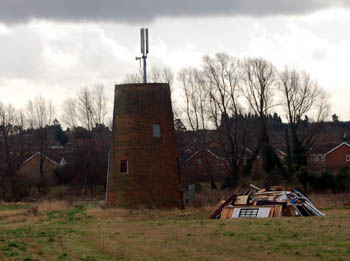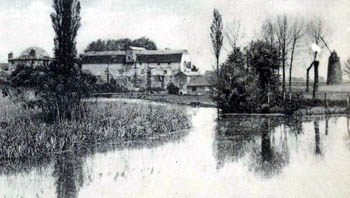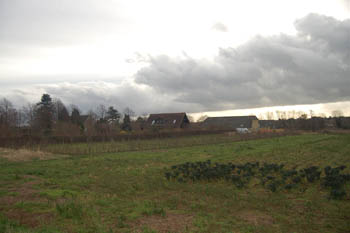Shefford Mills

The remains of the windmill in the landscape, January 2008
Shefford windmill stands a few yards inside the parish boundary with Southill whilst the site of the watermill is some yards west of it. Both buildings, although seemingly known as Shefford Mills throughout their recorded history were, for most of that history divided between the parishes of Clifton and Southill. The mill buildings straddled the northern bulge of the River Ivel, everything on the north bank, including the windmill, was in Southill whilst everything on the south bank was in Clifton. From available records it seems as if both windmill and watermill were always in the same ownership and same occupation but this cannot be stated categorically.
A number of early 19th century deeds refer to the mills as "tythe mills" and note that they had previously been in the ownership of Chicksands Priory, showing that they were in existence at least in 1539 when the priory was dissolved. The earliest direct mention of a mill or mills at Shefford in any document held by Bedfordshire Archives comes from the Campton parish registers where the burial of a Warrin alias Wealler of Shefford, miller is recorded in 1657.
In a deed securing an annuity [ref: BS858-859] it is recited that an L.Perrey granted the rents of two water mills called tithe mills in Clifton and Shefford to Felix Wilson and Robert Morgan in 1611. The deed itself witnesses the transfer of rents from John Perrey to Katherine Ashenhurst to secure a £50 annuity in 1690.
The next document to mention the mill is a marriage settlement of the somewhat ludicrously named Pattee Byng with Lady Charlotte Montagu in 1724 [ref: W2132]. One of the properties conveyed to trustees of the settlement was a messuage and mill house with five water grist mills [i.e. pairs of millstones]under one covert called Shefford Mills in Southill with mill pools, dams, banks, water and going gear belonging formerly in occupation of Joseph Franklyn, miller, now Martin Haycock, miller. Interestingly Joseph Franklyn is recorded as a miller in Chicksands in the Campton parish registers from 1702 to 1719. Another Joseph Francklyn (or the same man married to a second wife) is recorded from 1719 to 1727. This may show either: that Francklyn gave up being miller in Shefford before 1702; or that he lived in Chicksands and worked in Shefford; or that the old link between Chicksands Priory and Shefford Mills was remembered so that the one was regarded as part of the other (unlikely); or that it is a different, though perhaps related, Joseph Francklyn!

Shefford Mills [ref: Z60/7]
The Campton parish registers show that by 1735 Martin Haycock had given way to William Newman as his son William was baptised in that year and William the father is described as being of Shefford, miller. In 1765 a mortgage for £8,000 from George, 3rd Viscount Torrington to William Daniel included Shefford Mills as part of the security [ref: W2150]. the description of the mills is the same as that in 1724 with the addition that a Thomas Quire is recorded as in occupation before Joseph Francklyn.
In Volume 14 of the Bedfordshire Historical Records Society of 1931, J.Steele Elliott in an article on Bedfordshire windmills notes that on Thomas Jeffreys' map of 1765 a windmill is shown on the north side of the road leading to Clophill [Ampthill Road] about a quarter of a mile from the church. This is the only known reference to such a mill.
In 1775 George Byng, 4th Viscount Torrington exchanged land including Shefford Mills with John Dilly, gentleman [ref: X215/1-2], ending the Byng family's ownership of the mill which went back to at least 1724. The next reference to a miller is, again, from the Campton parish registers: in 1787 James, son of James Dobson of Shefford, miller, was baptised.
In 1806 the Bodger family began its ownership of Shefford Mills when John Dilly's brother Charles sold the mill, with other lands, to Richard Bodger of Southill gentleman [ref: X215/1-2]. The mill is described as a farmhouse with water mills, heretofore called Tythe Mills and now called Shefford Mills in Southill and Clifton parishes near Shefford, part possessions of the late Priory of Chicksands and in occupation of John Waller alias Warren. This last character is obviously not the current miller but the John Warrin alias Wealler who was buried in 1657, showing how old the property descriptions in deeds sometimes are!
In 1809 George Edwards wrote a memorandum to William Bodger, son of Richard, stating that he had "drawn a kiln" of 4,000 bricks and also had 6 quarters of lime reserved for him and asking if he still wanted them [ref: Li/LibB1/19/7 p.34]. Bodger junior obviously had a large building project in mind at the mills, one wonders if this was the later windmill, which is mentioned in no record hitherto. J.Steele Bodger in his 1931 article reckoned that this mill had been built by Henry Haynes in 1835 but gives no source or reference for this assertion. Richard Bodger made his will in 1811, which was proved in 1812, leaving the mill to William [ref: X215/3] who, as can be seen may already have been acting as miller.

Remains of the windmillm January 2008
J.Steele Elliott's article on Shefford windmill states: "The skeleton of a cone-shaped brick tower, standing in the field adjoining the water-mill, half a mile distant N.E. of the Church and equi-distant between the river Ivel and the road leading to Stanford marks the site of the mill…erected by Henry Haynes of Shefford about this year [1835]. It ceased working about 1880, and two of the four decrepit sails were still in position as late as 1927. The brickwork of the tower is still at its original elevation, and is 40 feet in height; it measures 24 feet over the base, with 22-inch walling. There appear to have been four floors above the ground, and it worked three pairs of stones. The dome was of sheet copper, which was stripped off and sold during the Great War. The overall of sails was about 50 feet. This mill was built to augment the water-mill, but its low and sheltered position was far from satisfactory, and its handicapped ability was answerable for a brief career…"
William Bodger of Shefford Mills, mealman, owned a good amount of land in Clifton, Meppershall and Southill and an abstract of his title including [HF13/5/25] includes record of a mortgage of Shefford Mills [which may be a reference to wind and watermills or simply to the fact that there were, as we have seen, five mills, or pairs of millstones, at the watermill] in 1811 in which the long defunct John Waller alias Warren is still noted as tenant. A more up to date deed of 1815 gives the occupier as John Northwood, although who can say, given the accuracy of tenure of the preceding deed, at what point in the last hundred and fifty years he was actually in occupation? A deed of 1830 describes the mill as formerly in occupation of John Northwood, now William Bodger. [ref: X215/8]
Over the next fifty years a good number of mortgages and assignments of mortgage are documented in the Gudgin archive of Shefford Mill records [ref: X215]. These show that by 1844 William Bodger had moved to Essex and was calling himself "farmer". A claim for registration, and therefore a claim for outdoor relief under the Poor Law of 1834 in the Meppershall parish archive [ref: P29/19/1] was made by a George Kempster of Shefford Mills in 1846. He may have been the former miller, fallen on hard times, or have lived at one of the six cottages built around the mill. Certainly in 1856 Richard John Bodger was miller, he is noted as such in a conveyance of the equity of redemption of the mill by William Bodger [ref: X215/9] and directories since 1850 term him as the miller.

Shefford Mills about 1920 [ref: X498/10]
In 1865 Richard John sold the mill to William James Bodger [ref: X215/16] then in 1869 the mill was sold by auction. The sale particulars [ref: X215/20] describe the mills (Lot 1) as follows: "The spacious partly brick and timber-built and slated STEAM & WATER FLOUR MILLS, 4 STORIES HIGH and STAGE with extensive STOWAGE FOR CORN, with Brick, Timber, and Tiled 6-Bayed BOILER HOUSE, STORE HOUSE, and CART SHED, with large BRICK SHAFT, WASTE WATER GATE, BRICK-BUILT COUNTING-HOUSE communicating with Mill and House.
Boiler House, Engine House, and ground Floor of Mill; a nearly-new Cornish Boiler, 6 feet diameter, 18 feet long, with two 27 feet tubes and fittings, and connections to a 25 (nominal) Horse-Power Condensing Engine (by HORNE, of Westminster) fitted with High and Low Pressure Cylinders, and connected with Spur and Counter Gear for driving 8 Pairs of French Burr Stones, 4 pairs fitted with Silent Feed Apparatus, and 4 pairs with Damsel ditto; an 18 inch Iron Breast Water Wheel, 8 feet 6 inches wide, with Rack Down Gate and 9 foot Fall; an Iron Pit Wheel, Wallower, Iron Upright Shaft, and Spur Wheel, 5 Stone Nuts and Spindles, with fixings. The whole in good working condition.
STONE FLOOR. 13 Pairs of French Burr Stones, a Jumper, a Bran-Room, and a large Loading Chamber.
MACHINE FLOOR. Iron Crown Wheel, 2 Nuts and Shafts with 6 Pullies for sriving and Dressing and Smutting Machinery and Sack Tackle, upright Spindle and Driving Pullies as fitted to Smutter, one 18 inch cylinder Dressing Machine and large Pastry, and 2 Bolting Machines.
BIN FLOOR. Six large Wheat Bins, one ditto for Smut-Machine, one ditto for Bolting-Machine, and one very large ditto for Dressing-Machine.
LARGE STAGE. Two sets of Sack tackle fitted for Mill and Lucomb, set of Elevators to Smut Machine with counter shaft and pullies for driving the same, and Stage over Dressing-Machine.
Connected with the Mill Head is a Reservoir of nearly 3 Acres.
A COMFORTABLE PARTLY BRICK-BUILT DWELLING HOUSE, Containing capital Entrance Hall, Breakfast Parlour, Dining-room with bow Window and folding glass door overlooking Lawn and River, Drawing-Room with front door to Lawn, 7 Bed-Rooms, 2 Staircases, Kitchen, Larder, Side Entrance, and good Cellar; Court Yard with Brew-House and Wood Shed, Range of Brick, Timber and Pantiled and Asphalte Buildings used as Cart Horse Stable, enclosed Store House and Shed, 31 yards by 21 yards, Cart Shed.
Partly Walled-in FLOWER and KITCHEN GARDEN overlooking the River Ivel.
A SUBSTANTIAL BRICK TOWER WINDMILL with 3 Pairs of French Burr Stones with overhead Driving Gear, iron upright Shaft and Wallower, iron-bound Shaft and Woof Break with part of 4 pair of patent Sails”. Also being sold were 21 acres of garden, meadow and pasture land, four (formerly six) cottages and 23 lots of building land.
Richard John Bodger's widow, Mary was the one making the sale; the buyer was Edward Bodger of Southill, gentleman [ref: X215/21] who immediately mortgaged it to Henry Campion [ref: X215/24]. In 1888 an abstract of title of Edward Bodger to the mill was produced, presumably as it was about to be sold [ref: X215/29], a reconveyance of 1894 [ref: X215/30] by mortgagees suggesting that it was sold in 1888 or 1889 to Joseph Gudgin of Hill Farm, Broom

Shefford Mill [ref: Z1306/101/15/1]
In 1926 or 1927 the mill was valued under the Rating Valuation Act 1925; every piece of land and building in the country was assessed to determine the rates to be paid on it. The valuer visiting Shefford Mill [ref: DV1/C124/118] noted that both owner and occupier was Charles Frederick Gudgin and that the building was constructed of brick, wood and slate. It was a corn and grist mill ["no flour trade"] and produced about 5 quarters per week on average from just two pairs of stones. One mill [i.e. pair of stones] was used for rolling the grist. The premises had four floors ["One Floor has been taken off Top"] and had "Only water power" which "gets short in Summer", evidently the steam power mentioned in the deed of 1869 was no longer used.
Overall the building had been one third pulled down since 1913.
The watermill no longer stands. It was Destroyed by flood 1959. The windmill still stands, though in a rather sorry state, Bedfordshire County Council booklet Bedfordshire Mills by Hugh Howes, published in 1983, noting that it was, at that time, used for fruit storage.
A tentative list of millers can be constructed as below:
- 1657: John Warrin alias Wealler
- before 1724: Thomas Quire
- before 1724: Joseph Francklyn
- 1724: Martin Haycock
- 1735: William Newman
- 1787: James Dobson
- before 1806?: John Northwood
- 1806 to 1812: Richard and/or William Bodger
- 1846: George Kempster?
- 1850-1869: Richard John Bodger
- 1869-1888: Edward Bodger
- 1894-1910: John Samuel King
- 1914-1928: Charles Frederick Gudgin
- 1931-1940: Gudgin & Son

Site of Shefford watermill, January 2008